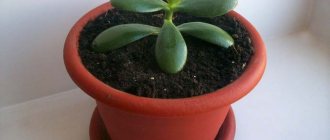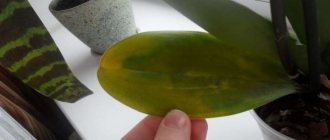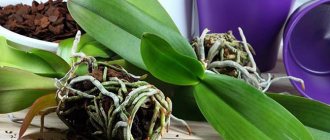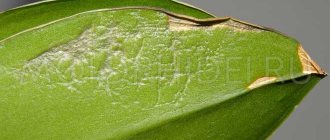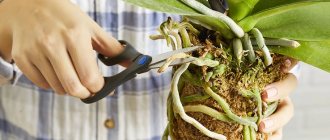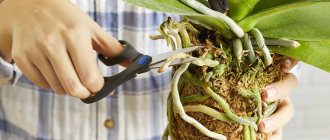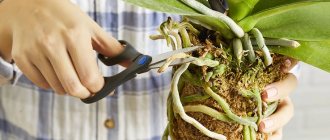How to plant a baby orchid? Sooner or later, every gardener begins to be interested in a similar question. The formation of children on the mother specimen is a natural process for the plant. Essentially, a baby is a copy of an adult orchid, but in miniature. Once matured to the point where it can be planted, it will have all the characteristics of an adult plant and will be able to grow on its own. Most often, the baby has a stem, leaves and roots at the time of its transplantation, but sometimes it can even produce a flowering shoot and bloom. It looks quite beautiful - an orchid in miniature.
Reproduction by lateral layering
Orchid babies are young shoots of the plant that periodically appear on the stem and roots, but more often on the peduncle. They have their own miniature stem, nascent roots and leaves.
Reference! With proper care, babies can appear on their own, but you can wake up the “sleeping bud” on the peduncle - remove the protective scale and carefully treat it with cytokinin paste.
The role of children in the life of an orchid is difficult to overestimate, since it is their continuation. Propagating the plant by lateral layering is quite simple - this is the fastest way.
What it is?
Children are called shoots that appear on an adult plant during the growing season. Reproduction begins from the appearance of a compaction, in place of which a bud is formed. A baby grows from it, which has its own roots, stem, miniature leaves and peduncle.
Sometimes the sprout blooms directly on the parent orchid. The plant's vegetation begins to grow in late spring, summer or early autumn. In winter, the birth of children from an adult orchid is unlikely.
Where do the buds appear?
Children can appear on different parts of the plant:
On the peduncle , after the plant has faded, a young sprout appears.
It is worth noting that not one baby may appear, but several, and they can be located anywhere on the peduncle, both in the middle and at the very end. But usually only one process appears. Do not rush to remove the peduncle; create the correct temperature and proper air humidity so that the orchid sends out shoots that can later be planted. At first, the shoots are very small, but over time, small compactions will appear on the sides - roots will begin to form.- At the roots , children also appear quite often; in this case, when separating, you need to act with the utmost caution, since there is a possibility of damaging the roots of an adult plant.
- On the trunk – it is not recommended to remove these shoots.
They do not have their own root system. In addition, when separating, you can damage the stem of the plant, which can simply cause it to die. A baby may appear on the stem if the growth point begins to freeze. After the mother plant dies, the baby will continue to grow.
How to correctly separate from the peduncle and base?
The procedure for separating a baby depends on the presence of roots in the shoot, which is determined by the location of the shoot formation on the parent orchid. If the shoot has grown at the base of an adult flower, then there will be roots.
- Check the strength and length of the roots.
- Disinfect the instrument.
- Cut off the finished baby.
- After cutting, separate the roots of the shoot and the mother orchid.
- Sprinkle the cut with cinnamon or activated carbon.
The procedure of separating the shoot with roots simplifies the task of replanting. The baby that has grown on the peduncle is separated in three steps.
- Disinfect cutting tools.
- Cut off the young shoot, capturing part of the peduncle and leaving a couple of centimeters on the branch of the mother plant.
- Sprinkle the cut area with activated carbon and let it dry.
Attention! The shoot that grows from the trunk of the orchid cannot be separated under any circumstances, since it and the flower feed from the same root. The new plant will not be able to survive on its own.
Consequences for the parent
Some novice flower growers do not remove children from the mother plant, especially if shoots have formed near the roots, mistakenly believing that this way the plant will be more bushy and beautiful. But this is wrong, since the mother plant spends a lot of energy on the development of the shoot, and if the baby is not removed in time, it may simply die.
So there are two main questions:
- When should you separate the baby from the plant?
- How to do it right?
Attention! A baby that was planted on time and successfully is a new independent plant in the collection. But the gardener is often faced with a choice - a mother plant or a baby plant, if a shoot appears on the stem.
When to plant a shoot?
If an orchid has babies, then the question arises: when should they be planted? There are several main signs of readiness:
- Overgrown roots.
While they are gone, the process should not be touched. The roots must be healthy, strong, and at least 5 cm long. It is worth remembering that the more roots a child has, the more likely it is that the transplant will be successful and the young plant will survive. You should not separate a shoot if it has less than three roots. - The right amount of real leaves .
A young orchid must grow at least 5 leaves; this is the only way it will have a high chance of survival after separation from the mother plant. Do not forget that good leaves are the plant's nutrition from sunlight and respiration. - The baby spent at least 8 months on the mother plant , but it is better if exactly a year passes after its appearance.
Do not rush to separate the baby from the mother, let it gain strength for further growth while on the mother’s plant. Growing the root system is a tedious and long process. Preparing items for replanting (tools, soil, pot).
So, the baby is ready for transplantation, now it’s time to prepare everything necessary for this exciting process:
- special substrate made from pieces of bark 1 cm long;
- sphagnum moss;
- a small plastic pot - with a diameter of 7 to 10 cm (it must be transparent);
- pruning shears, scissors or sharp knife;
- activated charcoal or cinnamon.
To prepare your own soil, you need to mix fine pine bark and sphagnum moss, you can add a little charcoal. The substrate should be well moistened, but not wet .
Read more about choosing soil and pot here.
How to properly separate a shoot?
This can be done in several steps:
- Sterilize the instrument.
- Carefully cut the baby from the mother plant. If it grows on a peduncle, then it is worth making oblique cuts on both sides of the shoot, so that the remainder of the peduncle is 1-2 cm. If the baby is formed at the base, then it is more difficult to plant it: make the cut as carefully as possible so as not to damage the roots, both on the mother plant and on the baby plant.
- The cut areas should be treated with cinnamon or crushed activated carbon. This must be done, otherwise pathogenic bacteria and infections may get into the wounds.
To finally figure out how to separate an orchid shoot, watch the video:
Basic recommendations
Before planting the baby, the sections need to be air dried for 30 minutes . The pot should be small; you can take a simple plastic cup and make several holes in it, both at the bottom and on the sides.
When is the best time to plant a shoot?
Separation of a shoot from an adult flower is a long and painstaking process, since only after 6 months the formed baby is ready for separation and rooting in the ground. This happens when the baby has:
- several roots;
- root length more than 5 cm;
- at least two pairs of leaves.
Only in this case is the shoot capable of independently absorbing moisture and nutrients from the soil.
Detailed step-by-step instructions and photos
With root system
If the baby already has roots, then replanting a small plant will be quite simple.
The algorithm of actions is as follows:
- Take a plastic container with holes.
- Place a layer of drainage on the bottom, then a substrate mixed with moss. Moisten the mixture. But before this, it is worth spilling the soil with a pink solution of potassium permanganate or calcining it in the oven for disinfection.
- Place the baby in the cup very carefully, so that the growth point is at the level of the edges.
- Adding the substrate must be done with extreme caution, since the roots of the young plant are very delicate.
- The roots should be completely covered with the mixture.
- You should not water after transplantation, as an infection may get into an unhealed wound.
- Cover the plant with a transparent plastic bag - it will be a mini-greenhouse for better rooting.
Important! The substrate should not be very waterlogged, as there is a risk of tear rotting. At the same time, in the greenhouse it is necessary to ensure the optimal level of humidity for the young plant.
Without roots
There are situations when a baby grows and develops well on the mother plant, it can even bloom, but it does not want to produce roots. What to do in this case?
You need to proceed as follows:
- Place some drainage and moss in a plastic cup with holes.
- Make two holes in the side of the cup opposite each other for support.
- Install the support.
- Place the baby's socket on a support - it should not touch the ground.
- Place a plastic bottle with a cut bottom on top.
- The young orchid will remain in this state until roots appear.
It is worth observing the plant, since ideally the transplant should be carried out only after the roots have grown at least 5 cm . It is worth being patient, as this process is quite long and can take 4-6 months.
If it grows on a peduncle
If the orchid has sprouted on the peduncle, then the procedure is as follows:
- Use a sterile pruning shears to cut the baby from the peduncle.
- At the base of the rosette we find a scale that should be removed, since it is this that prevents the roots from developing.
- Now you can start growing roots in the air, since it is impossible to place the plant in a substrate without roots.
- We arrange a plastic cup with holes under the pot.
- Place drainage on the bottom and place moss on top.
- Make two holes at the top for support.
- Place the baby so that it hangs in the air without touching the moss.
- Cover the structure with a young orchid with a cut plastic bottle or plastic bag to create greenhouse conditions. The microclimate in the greenhouse should be close to tropical.
Transplanting a plant into a separate substrate
Transplanting a new plant into a separate substrate is quite simple, but you still need to know some details. First you should prepare for this procedure. To do this, the separated cuttings (described above on how to properly trim the baby) need to be soaked in water for at least 15 minutes. If desired, you can add a growth enhancer to the water (any one is suitable, but you need to dilute it correctly - following the instructions). Why is soaking necessary? Wet roots are more flexible and less susceptible to being placed in a pot.
Now take a container for the plant. You need to lay a drainage layer on its bottom. You can use vermiculite, expanded clay or ceramic shards. Choose the option that is convenient for you. Next, the plant is lowered into the pot and held so that the leaves are higher than the top point of the pot. The substrate is carefully poured so as not to injure the roots. In this case, you need to lightly tap on the sides of the pot so that the soil is evenly laid. But do not pack the soil mixture too tightly, as aerial roots need access to carbon dioxide for nutrition. Leave the plant in this form for two to three days, after which you can water the plant.
Advice! First, the baby separated from the mother specimen must be placed in partial shade. After a few days you can install it in diffused light. But make sure that the baby is not exposed to direct sunlight, which will lead to burns.
What can be used to speed up the formation of the root system in a baby orchid? A good choice would be one of the following drugs, which can be purchased at a specialty store:
- "Ribav-Extra". The manufacturer positions the composition as a root former. It is used to treat flowers, as an anti-stress agent and to accelerate the formation of roots in young plants, ensuring their better survival. The composition is diluted on the basis that two drops of the product are needed per liter of water.
- "Zircon". This drug is universal. That is why, when diluting it, you need to make a weaker solution than indicated in the instructions, so as not to harm the orchid. For a child, it is enough to add four drops of the product to one liter of warm, settled water. The drug itself belongs to the group of phytohormones, so it can be considered one of the best feeding options. The basis of the product is an extract of Echinacea purpurea.
- "Radifarm". The drug is developed on the basis of various plant extracts. It is able to actively stimulate the growth of the root system, ensure better survival rate and guarantee the survival of plants. For an orchid, it is important to dilute the composition correctly: add one drop of the product to a liter of water.
- "Etamon." The product has positively proven itself as a stimulator of root system formation. The main advantage of the product is the presence of phosphorus and nitrogen in the composition, which are necessary for the orchid. Correct dilution of the composition requires that you add one ampoule of the product to a liter of water.
As you can see, separating a baby from an adult orchid is a simple procedure. To ensure everything works out exactly, you need to follow the recommendations given. This is a guarantee that the plant will take root and no problems will arise. Remember that you cannot separate the baby while the orchid is blooming. Wait until the flowers fall and the plant enters the resting phase. Pruning small plants from the mother specimen during the flowering period is stressful for the plant, which can lead to a deterioration in its health: lethargy, falling leaves, and stunted growth.
Possible difficulties
The following problems may arise during transplantation:
- Infection .
This can not only lead to disease, but also to the death of the plant, so the pruner or knife must be sterile. - Decay .
Before planting the baby, you need to let it lie in the air for 30 minutes, then treat the cuts with ground cinnamon or wood ash. - If you cut off the shoot too early, it will die .
If there are several children on an orchid, then cutting everything off at once is strictly prohibited; the mother plant will simply die from the resulting injuries. Attention! Separate one baby first, the second can be planted as soon as the cut from the first is completely closed.
We have materials on orchid transplantation:
- when to replant;
- Is it possible in the fall?
- pruning roots during transplantation;
- transplantation during flowering;
- when releasing the arrow;
- after the purchase.
Tools for separating and transplanting Orchids
How to grow roots of an Orchid at home
Before separating the baby and transplanting it into new soil, you need to prepare the following tools:
- garden pruner;
- activated carbon (1 tablet) or ground cinnamon;
- alcohol for disinfection;
- a thin plastic pot with a diameter of 8–10 cm, there should be holes at the bottom;
- a sharp stationery or kitchen knife, you can use scissors;
All instruments must be thoroughly disinfected before use.
The soil must be prepared from three components:
- sphagnum moss;
- finely ground tree bark (pine);
- charcoal.
You can buy ready-made soil for orchids in the store.
For an orchid, a substrate is prepared from pine bark, sphagnum and charcoal
Where is the best place to transplant?
The separated orchid branch needs to be transplanted into new soil. Beginning gardeners should remember well how to plant an orchid shoot at home.
The orchid shoot can be transplanted into a greenhouse or polystyrene foam. If the baby has its own root system, it is planted in new soil. If it does not have roots, then it is suspended above a pre-prepared substrate and wait for the baby to take root. In both cases, the orchid needs to be grown in a greenhouse, which can be made from a large plastic bottle. A greenhouse will keep the orchid warm and moist.
There is another way to root an orchid shoot: the baby is planted in polystyrene foam. A hole is made in a piece of polystyrene foam and the base of the process is inserted there. The entire structure is placed in a glass of water and secured. You can cover it with a greenhouse or plastic wrap.
Important! The root of the baby should be under water until roots begin to appear. After this, the plant is transplanted into the ground.
The cut shoot is germinated in polystyrene foam

